Condensation Flow Heat Transfer Characteristics of Stainless Steel and Copper Enhanced Tubes
Abstract
1. Introduction
2. Experimental Details
3. Results
3.1. Data Analysis
3.2. Evaluation of Smooth Tube Condensation Correlations
3.3. Condensation Enhanced Heat Transfer Factor in Enhanced Tubes
3.4. Evaluation of Enhanced Heat Transfer Performance Factor
3.5. Evaluation of Condensation Correlations in Enhanced Tubes
3.6. Effect of Tube Material on Enhanced Heat Transfer Performance
3.7. Influence of Tube Diameter on Condensation HTC
4. Conclusions
- (1)
- The EFh of the EHT-HB/D tube is the highest; its performance is closely related to increasing fluid disturbance and improving drainage. The structure of the EHT-HB/HY tube increases the local thermal resistance and inhibits heat transfer, while the drainage effect of the EHT-HB tube is better than that of the EHT-HX tube.
- (2)
- The best overall condensation heat transfer resistance characteristics (and the highest PF) are shown in the EHT-HB/D tube; it has a low friction pressure drop and high heat transfer performance. Additionally, the PF of the EHT-HB tube is greater than one, the PF of EHT-HB/HY is slightly higher than one, and the PF of EHT-HX is less than one. In general, when the mass flow rate increases gradually, the PF initially decreases and then increases.
- (3)
- Correlations that predict the condensation HTC of enhanced tubes are discussed and modified. For EHT-HX, EHT-HB/HY, and EHT-HB tubes, the deviation of all data points predicted by the Chato model is within ±15%. However, for the EHT-HB/D tube, a modification to the Haraguchi et al. model is necessary, and that modification can predict that 100% of the data points are within ±20%.
- (4)
- Thermal conductivity (SS and copper) of the tube material for smooth tubes has a minimal effect on its thermal hydraulic performance; however, for the enhanced tubes, the HTC increases with increasing thermal conductivity in extreme environments of condensation flow, at the saturation temperature of 318.15K with a saturation pressure of 2733.5 kPa. The refrigerant side convective heat transfer resistance dominates, while the wall heat transfer resistance makes up a modest fraction of the overall resistance. The thermal conductivity of the enhancement character (fin) affects the heat transfer for enhanced tubes.
- (5)
- The effect of tube diameter on condensation heat transfer in the enhanced tubes with different tube diameters is much higher than that of the enhancement surface structure. With the reduction of tube diameter, shear force and surface tension gradually replace gravity and become the dominant forces; this is conducive to the removal of the liquid film at the bottom.
Author Contributions
Funding
Institutional Review Board Statement
Informed Consent Statement
Data Availability Statement
Acknowledgments
Conflicts of Interest
Nomenclature
| A | test tube surface area, m2 |
| C | enhancement ratio |
| cp | specific heat, J/(kg·K) |
| D | dimple |
| d | test tube diameter, m |
| dh | hydraulic diameter, m |
| Fa | (ρl−ρv) σ/G2Dh |
| f | Fanning friction factor |
| G | mass flux, kg/(m2·s) |
| Ga | Galileo number |
| g | gravitational acceleration, m/s2 |
| HB | herringbone |
| HB/D | herringbone dimple |
| HB/HY | hydrophobic herringbone |
| HX | spiral microgrooves |
| h | heat transfer coefficient, W/(m2·K) |
| hlv | latent heat of vaporization, J/kg |
| k | thermal conductivity, W/(m·K) |
| Ja | Jakob number |
| l | liquid only |
| L | tube length, m |
| LMTD | logarithmic mean temperature, K |
| m | mass flux, kg/s |
| M | molecular weight |
| P | Pressure, kPa |
| PF | performance factor |
| Pr | Prandtl number |
| Q | heat transfer amount, W |
| q | heat flux, W/m2 |
| Re | Reynolds number |
| T/t | temperature, K/°C |
| U | Total heat transfer coefficient, W/(m2·K) |
| x | vapor quality |
| Xtt | Martinelli parameter |
| Greek symbols | |
| μ | dynamic viscosity, Pa·s |
| ρ | density, kg/m3 |
| ε | void fraction |
| σ | surface tension, N/m |
| ζ | area ratio |
| Φ | two-phase multiplier |
| Subscripts | |
| bulk | bulk temperature |
| exp | experimental |
| f | frictional |
| g | gravitational |
| i | inner |
| in | inlet |
| l | liquid phase |
| lat | latent heat |
| m | momentum |
| ni | actual heat transfer area |
| o | outer |
| out | outlet |
| ph | preheating section |
| pre | predictive |
| ref | refrigerant |
| s | smooth |
| sat | saturated |
| sc | sudden contraction |
| se | sudden enlargement |
| sens | sensible heat |
| t | total |
| te | test section |
| tp | two-phase |
| ts | test section |
| v | vapor phase |
| wall | wall parameters |
| w | water |
References
- Kim, Y.; Seo, K.; Chung, J.T. Evaporation heat transfer characteristics of R-410A in 7 and 9.52 mm smooth/micro-fin tubes. Int. J. Refrig. 2002, 25, 716–730. [Google Scholar] [CrossRef]
- Wellsandt, S.; Vamling, L. Evaporation of R134a in a horizontal herringbone microfin tube: Heat transfer and pressure drop. Int. J. Refrig. 2005, 28, 889–900. [Google Scholar] [CrossRef]
- Wu, Z.; Wu, Y.; Sundén, B.; Li, W. Convective vaporization in micro-fin tubes of different geometries. Exp. Therm. Fluid Sci. 2013, 44, 398–408. [Google Scholar] [CrossRef]
- Yang, C.M.; Hrnjak, P. A new flow pattern map for flow boiling of R410A in horizontal micro-fin tubes considering the effect of the helix angle. Int. J. Refrig. 2020, 109, 154–160. [Google Scholar] [CrossRef]
- Rollmann, P.; Spindler, K. New models for heat transfer and pressure drop during flow boiling of R407C and R410A in a horizontal microfin tube. Int. J. Therm. Sci. 2016, 103, 57–66. [Google Scholar] [CrossRef]
- Li, G.; Huang, L.; Tao, L. Experimental investigation of refrigerant condensation heat transfer characteristics in the horizontal microfin tubes. Appl. Therm. Eng. 2017, 123, 1484–1493. [Google Scholar] [CrossRef]
- Kukulka, D.J.; Smith, R.; Li, W. Condensation and Evaporation Characteristics of Vipertex 1EHT Enhanced Heat Transfer Tubes. Chem. Eng. Trans. 2014, 39, 727–732. [Google Scholar]
- Kukulka, D.J.; Smith, R.; Li, W. Experimental Comparison of the Evaporation and Condensation Heat Transfer Coefficients on the Outside of Enhanced Surface Tubes with Different Outer Diameters. Chem. Eng. Trans. 2019, 76, 31–36. [Google Scholar]
- Li, W.; Tang, W.; Gu, Z.; Guo, Y.; Ma, X.; Minkowycz, W.J.; Kukulka, D.J. Analysis of condensation and evaporation heat transfer inside 3-D enhanced tubes. Numer. Heat Transf. Appl. 2020, 78, 525–540. [Google Scholar] [CrossRef]
- Zhang, J.; Zhou, N.; Li, W.; Luo, Y.; Li, S. An experimental study of R410A condensation heat transfer and pressure drops characteristics in microfin and smooth tubes with 5 mm OD. Int. J. Heat Mass Transf. 2018, 125, 1284–1295. [Google Scholar]
- Gu, Y.H.; Liao, Q.; Cheng, M.; Ding, Y.D.; Zhu, X. Condensation heat transfer characteristics of moist air outside a three-dimensional finned tube. Int. J. Heat Mass Transf. 2020, 158, 119983. [Google Scholar] [CrossRef]
- Tang, W.; Sun, Z.C.; Li, W. Visualization of flow patterns during condensation in dimpled surface tubes of different materials. Int. J. Heat Mass Transf. 2020, 161, 120251. [Google Scholar] [CrossRef]
- Zhao, C.Y.; Ji, W.T.; Jin, P.H.; Zhong, Y.J.; Tao, W.Q. The influence of surface structure and thermal conductivity of the tube on the condensation heat transfer of R134a and R404A over single horizontal enhanced tubes. Appl. Therm. Eng. 2017, 125, 1114–1122. [Google Scholar]
- Ali, H.M.; Briggs, A. Condensation heat transfer on pin-fin tubes: Effect of thermal conductivity and pin height. Appl. Therm. Eng. 2013, 60, 465–471. [Google Scholar] [CrossRef]
- Ji, W.T.; Zhao, C.Y.; Zhang, D.C.; Li, Z.Y.; He, Y.L.; Tao, W. Q Condensation of R134a outside single horizontal titanium, cupronickel (B10 and B30), stainless steel and copper tubes. Int. J. Heat Mass Transf. 2014, 77, 194–201. [Google Scholar] [CrossRef]
- Li, W.; Guo, Y.; Gu, Z.B.; Ma, X.; Ayub, Z.; He, Y.; Kukulka, D.J. An Experimental Study of R134a Condensation Heat Transfer in Horizontal Smooth and Enhanced Tubes. J. Heat Transf. 2020, 142, 071603. [Google Scholar] [CrossRef]
- Zheng, B.; Wang, J.; Guo, Y.; Kukulka, D.J.; Tang, W.; Smith, R.; Sun, Z.; Li, W. An Experimental Study of In-Tube Condensation and Evaporation Using Enhanced Heat Transfer (EHT) Tubes. Energies 2021, 14, 867. [Google Scholar] [CrossRef]
- Kukulka, D.J.; Li, W.; Smith, R. An Experimental Investigation to Determine the Effect of Tube Material on the Tubeside Heat Transfer Performance of the Enhanced 1EHT Three Dimensional Heat Transfer Tube. Chem. Eng. Trans. 2021, 88, 397–402. [Google Scholar]
- Moffat, R.J. Describing the uncertainties in experimental results. Exp. Therm. Fluid Sci. 1988, 1, 3–17. [Google Scholar] [CrossRef]
- Ram, P. An Improved Approved Approximation for the Log-Mean Temperature Difference. Chem. Eng. 1988, 95, 110. [Google Scholar]
- Ziegler, F. Relationships between Temperature Differences in Heat Exchangers of Heat Transformation Devices. Rev. Gen. De Therm. 1998, 37, 549–555. [Google Scholar] [CrossRef]
- Gnielinski, V. New Equations for Heat and Mass Transfer in Turbulent Pipe and Channel Flow. Int. Chem. Eng. 1976, 16, 8–16. [Google Scholar]
- Petukhov, B.S. Heat transfer and friction in turbulent pipe flow with variable physical properties. Adv. Heat Transf. 1970, 6, 503–564. [Google Scholar]
- Rouhani, S.Z.; Axelsson, E. Calculation of void volume fraction in the subcooledand quality boiling regions. Int. J. Heat Mass Transf. 1970, 13, 383–393. [Google Scholar] [CrossRef]
- Shah, M.M. A general correlation for heat transfer during film condensation inside pipes. Int. J. Heat Mass Transf. 1979, 22, 547–556. [Google Scholar] [CrossRef]
- Cavallini, A.; Col, D.D.; Doretti, L.; Matkovic, M.; Rossetto, L.; Zilio, C.; Censi, G. Condensation in Horizontal Smooth Tubes: A New Heat Transfer Model for Heat Exchanger Design. Heat Transf. Eng. 2006, 27, 31–38. [Google Scholar] [CrossRef]
- Haraguchi, H.; Koyama, S.; Fujii, T. Condensation of refrigerants HCFC22, HFC134a and HCFC123 in a horizontal smooth tube:2nd Report, Proposals of Empirical Expressions for Local Heat Transfer Coefficient. J. Jpn. Soc. Mech. Eng. 1994, 60, 2117–2124. [Google Scholar]
- Huang, X.; Ding, G.; Hu, H.; Zhu, Y.; Peng, H.; Gao, Y.; Deng, B. Influence of oil on flow condensation heat transfer of R410A inside 4.18 mm and 1.6 mm inner diameter horizontal smooth tubes. Int. J. Refrig. 2010, 33, 158–169. [Google Scholar] [CrossRef]
- Chato, J. Laminar Condensation of Inside Horizontal and Inclined Tubes. Am. Soc. Heat. Refrig. Air Cond. Eng. J. 1962, 4, 52–60. [Google Scholar]
- Kedzierski, M.A.; Goncalves, J.M. Horizontal Convective Condensation of Alternative Refrigerants within a Micro-Fin Tube. J. Enhanc. Heat Transf. 1999, 6, 161–178. [Google Scholar] [CrossRef]

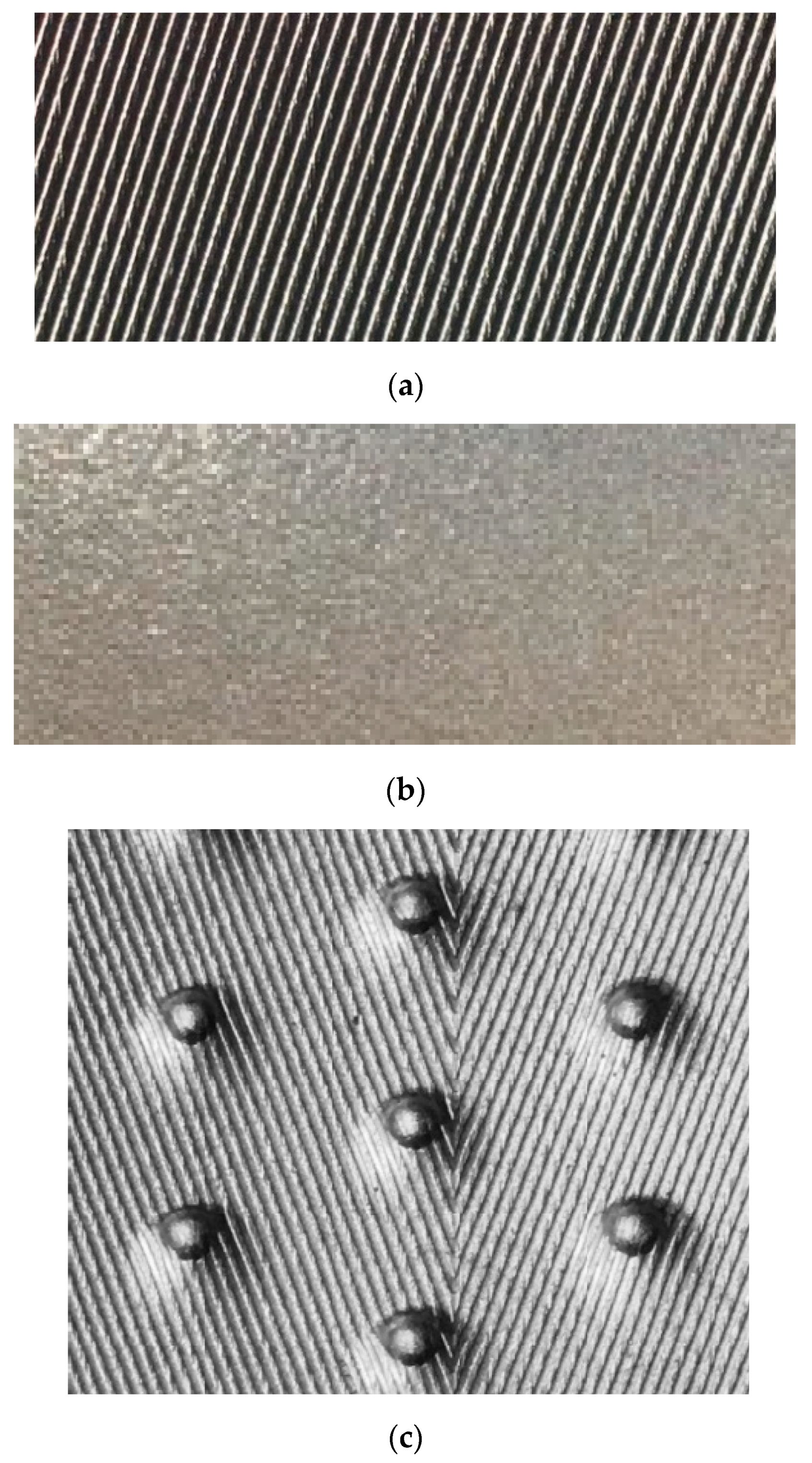
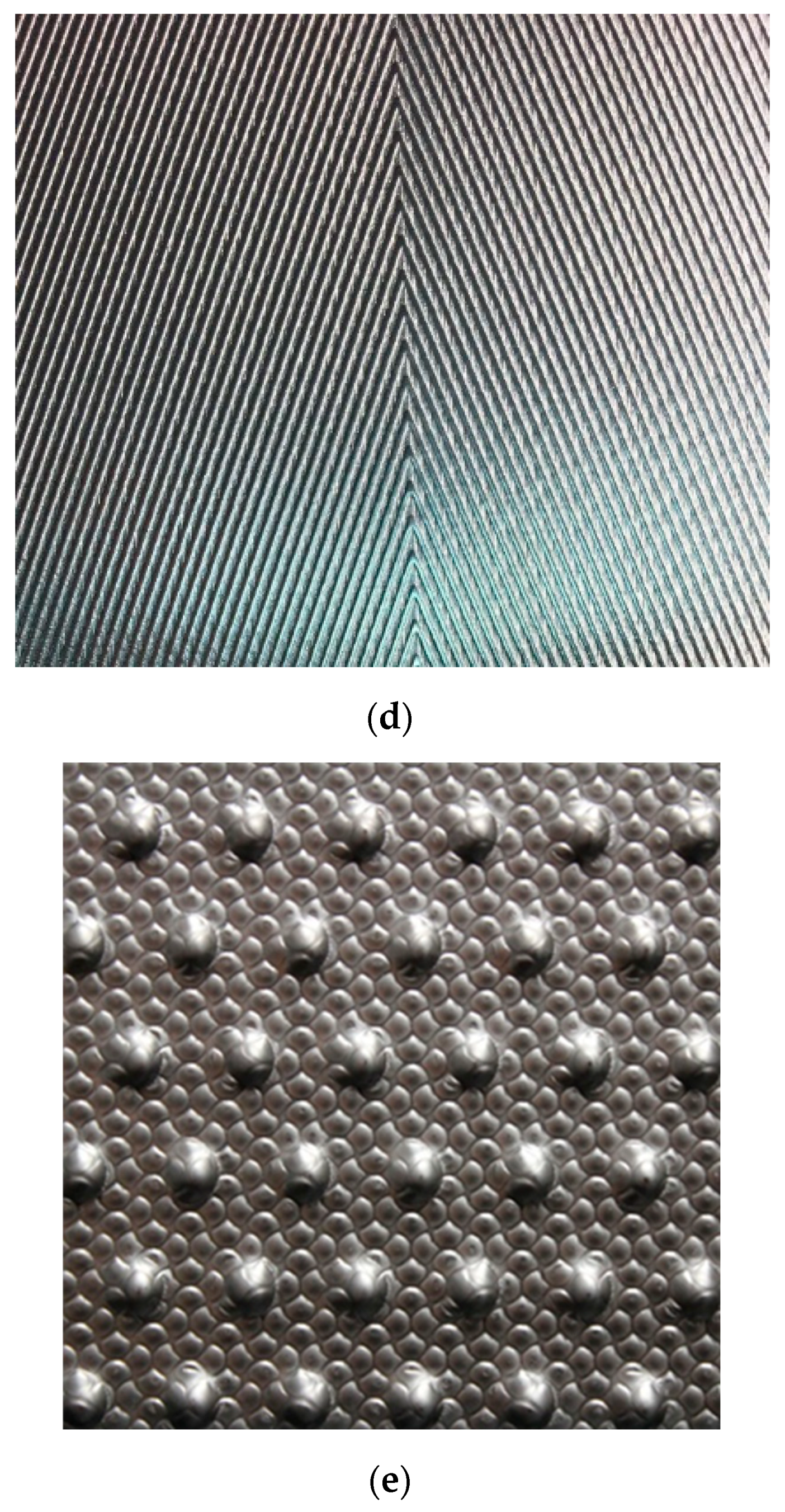
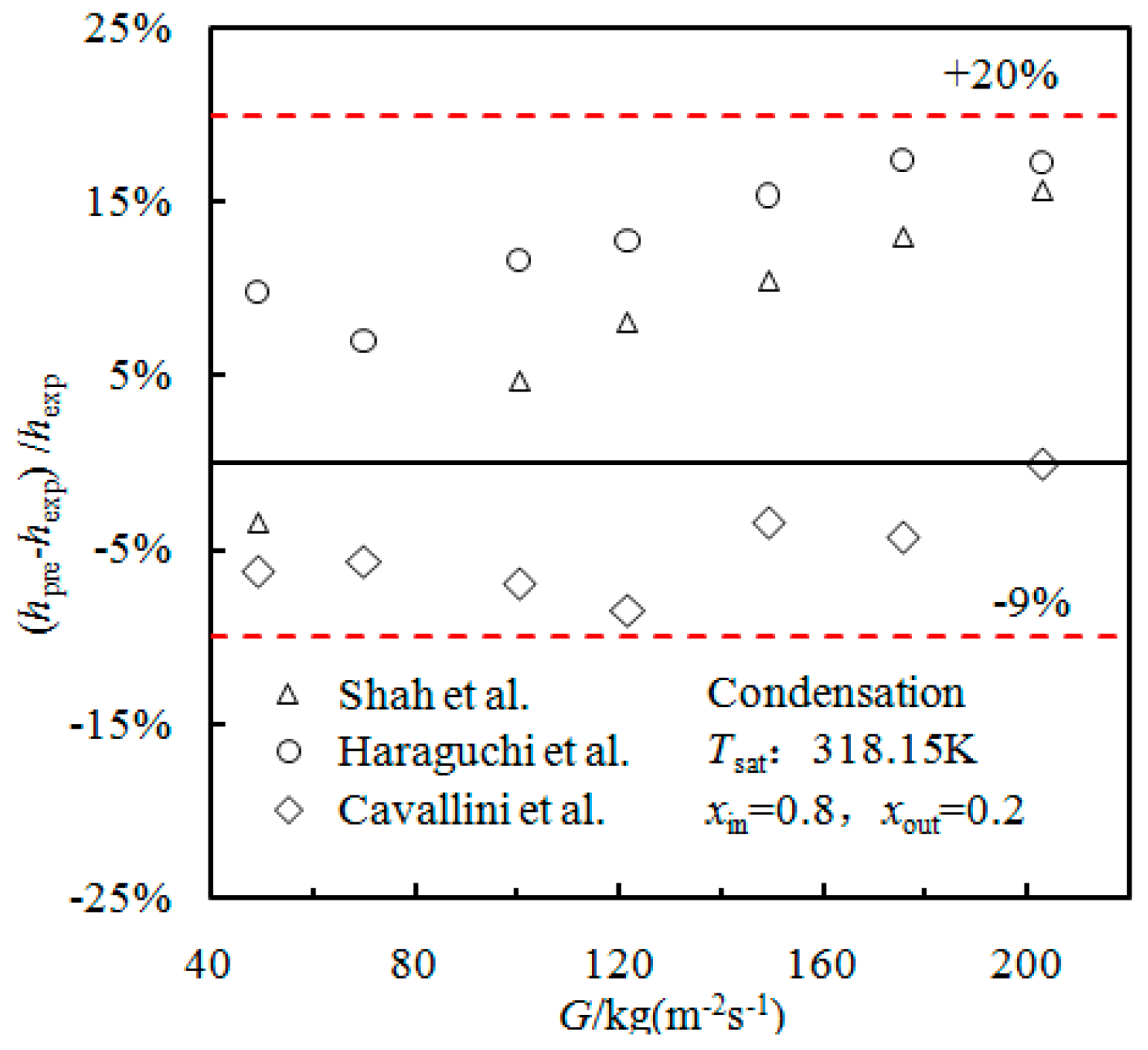
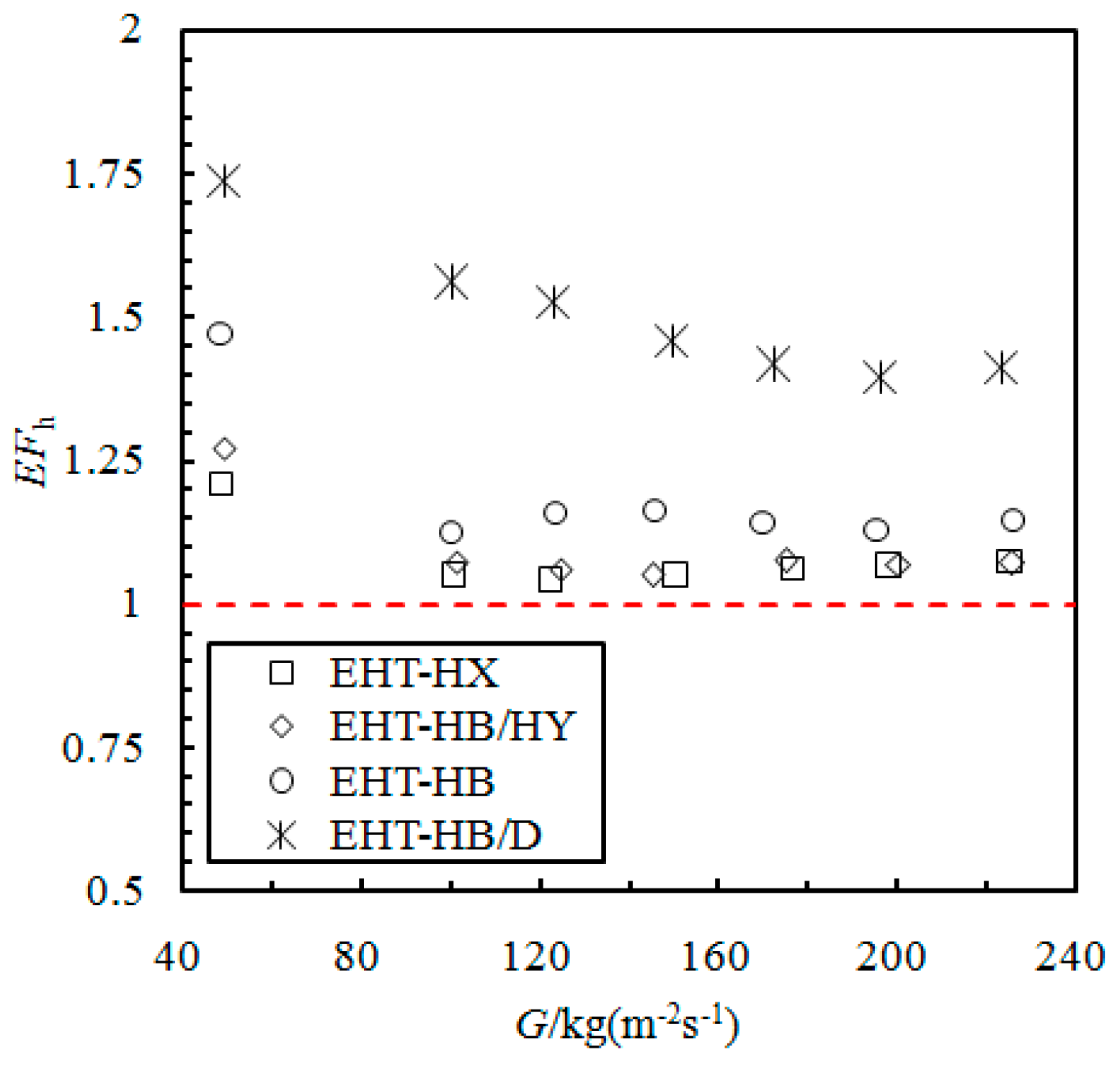
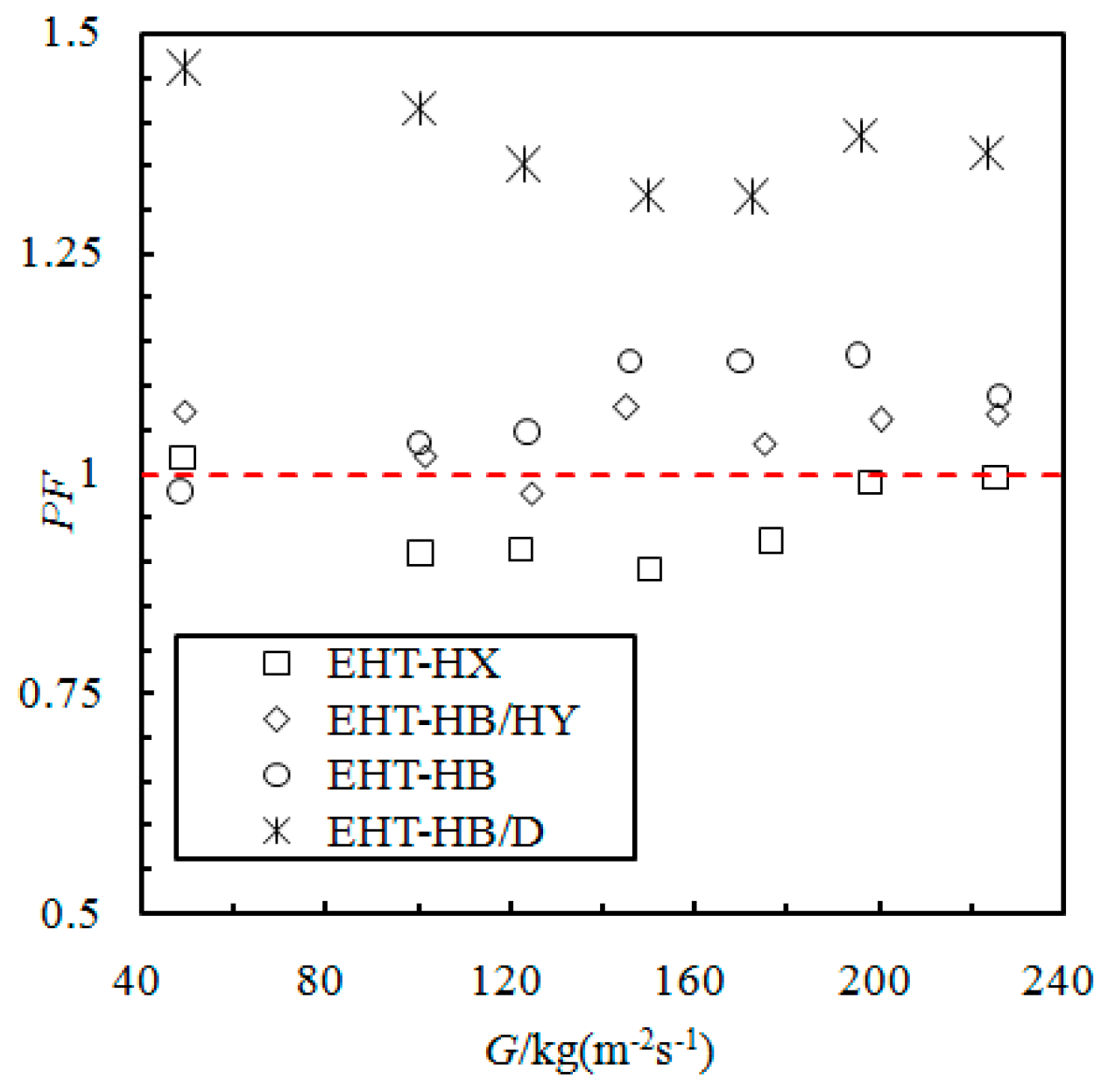
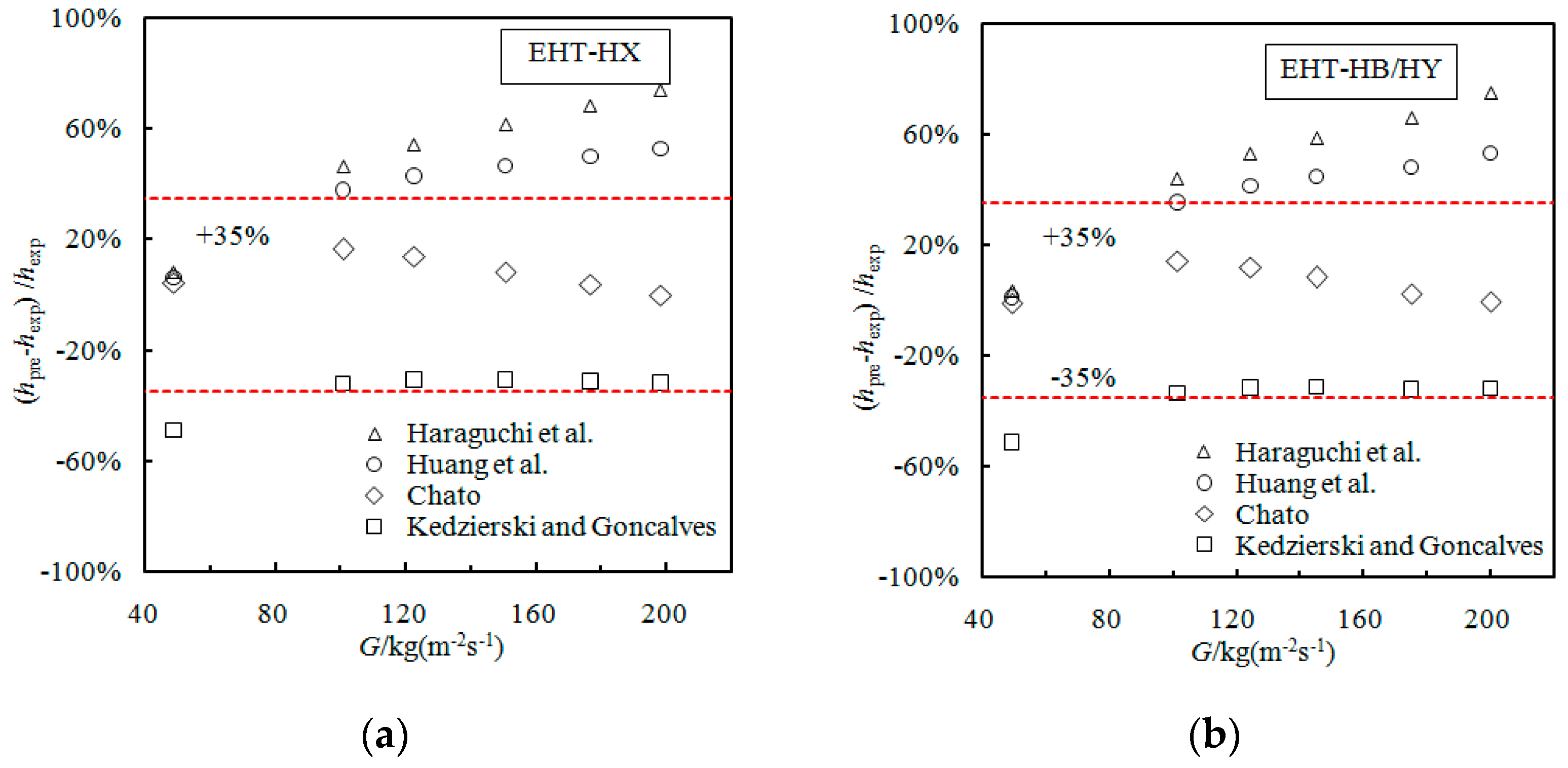
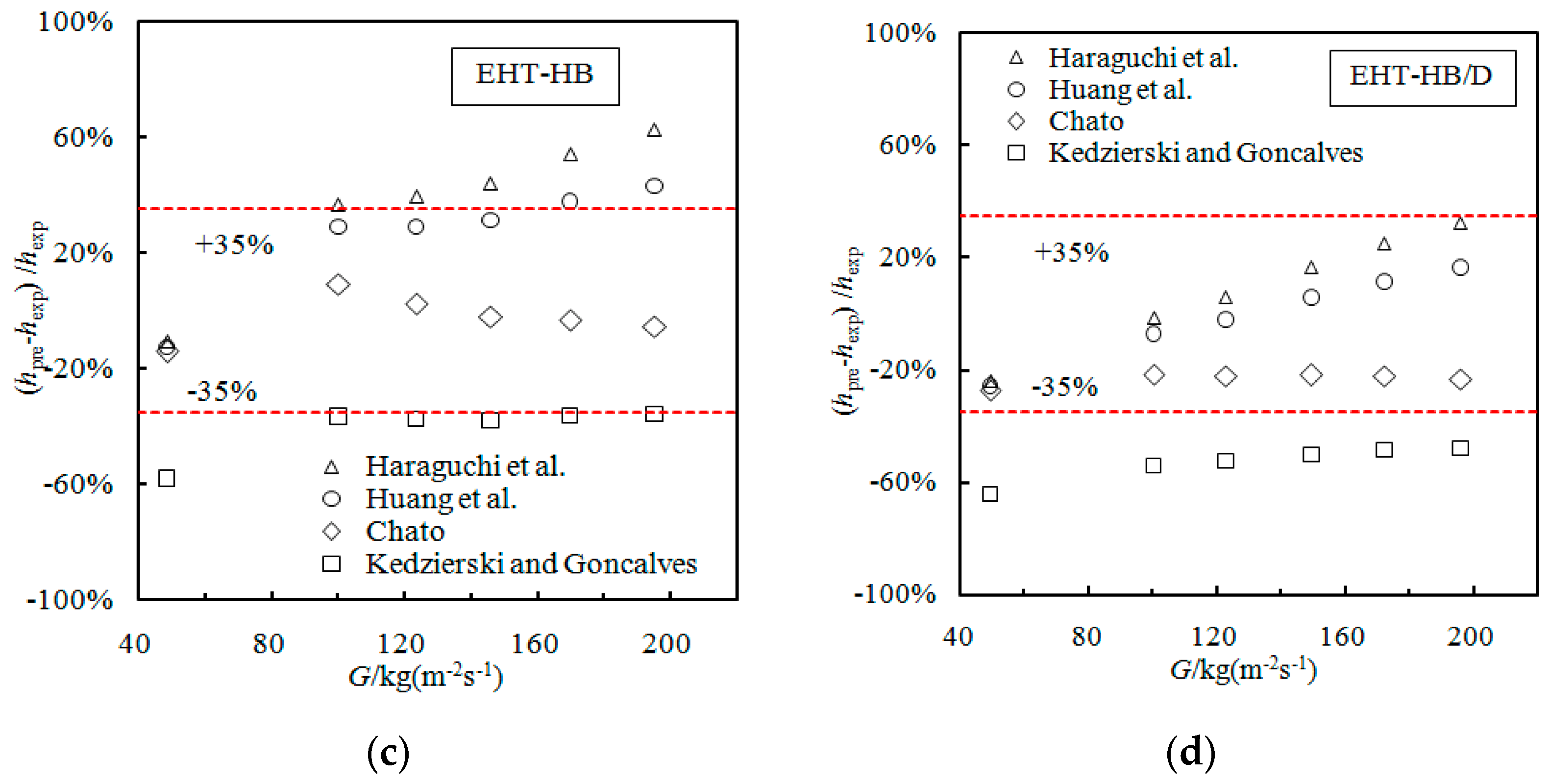
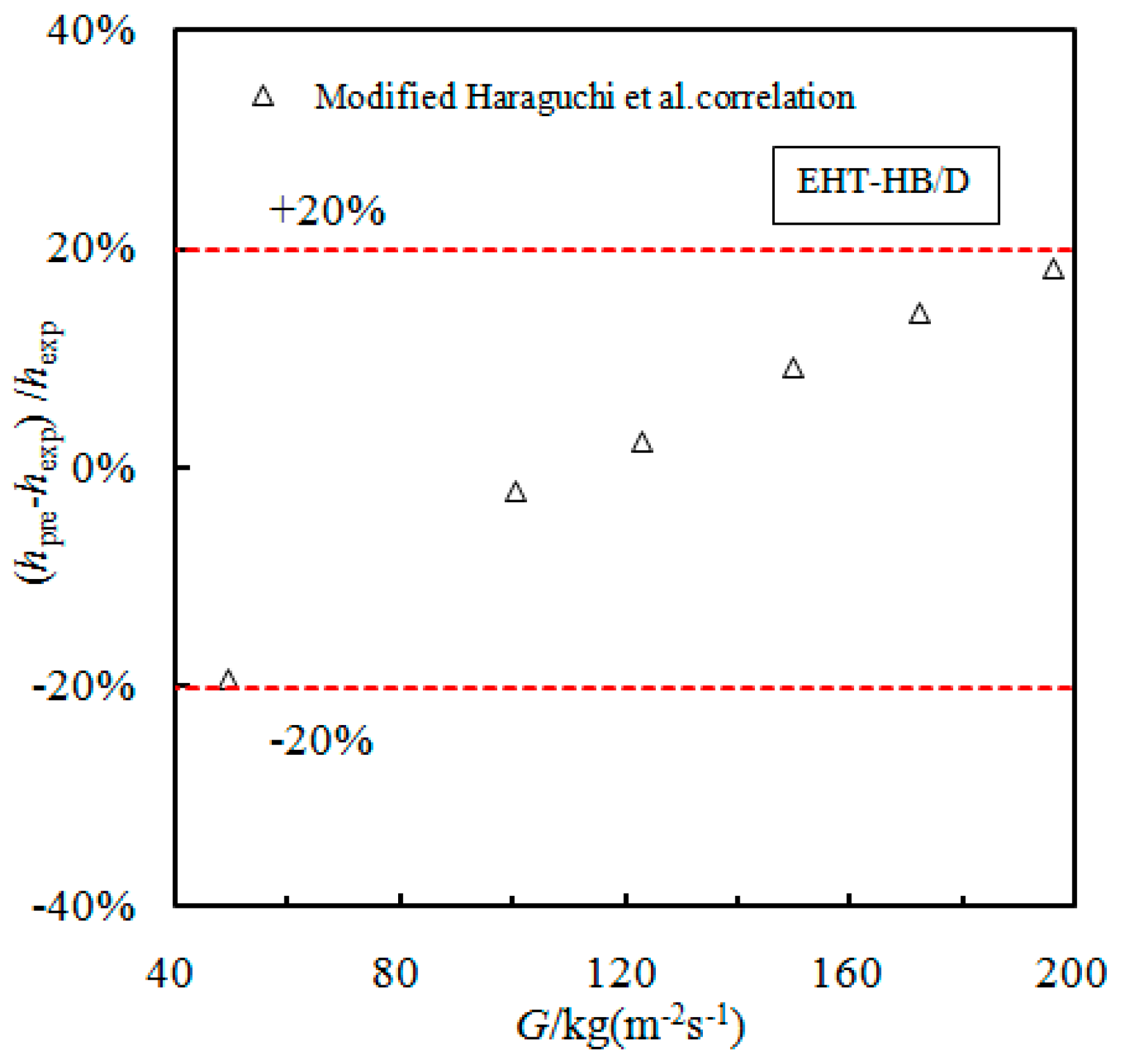



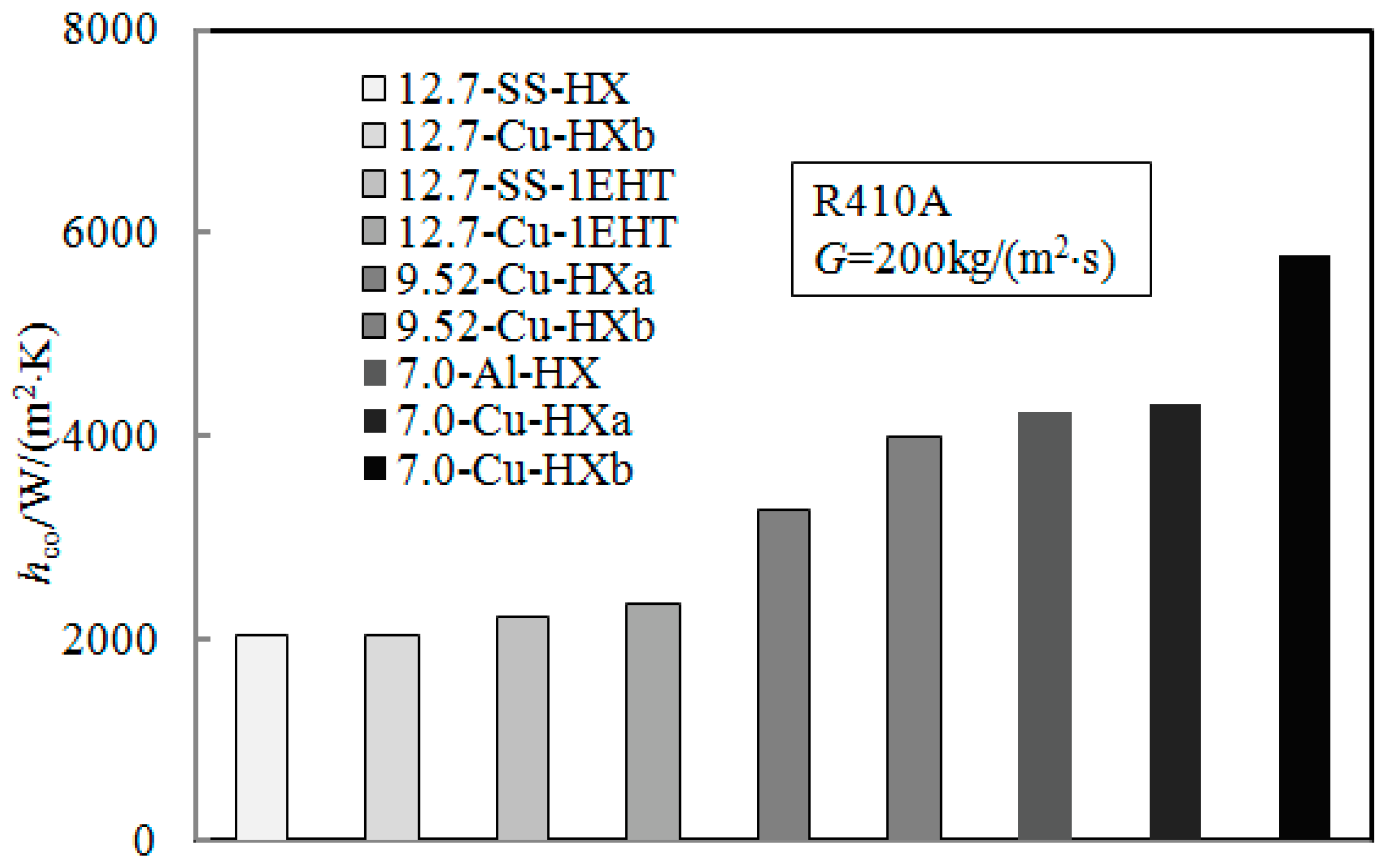
| Parameters | EHT-HX | EHT-HB | EHT-HB/D | EHT-HB/HY | Smooth | 1EHT | EHT-HX | EHT-HX | EHT-HX | EHT-HX |
|---|---|---|---|---|---|---|---|---|---|---|
| Material | SS | SS | SS | SS | Cu/SS | Cu/SS | Cu/SS | Al | Cu | Cu |
| Outer diameter (mm) | 12.7 | 12.7 | 12.7 | 12.7 | 9.52/12.7 | 9.52/12.7 | 9.52/12.7 | 7.0 | 7.0 | 7.0 |
| Thickness (mm) | 0.6 | 0.6 | 0.6 | 0.6 | 0.61 | 0.61 | 0.61 | 0.47 | 0.22 | 0.24 |
| Length (mm) | 2 | 2 | 2 | 2 | 2 | 2 | 2 | 2 | 2 | 2 |
| Dimple/fin height, mm | 1.14 | 0.08 | 1.21 | 0.08 | - | 0.19/1.71 | 0.25 | 0.06 | 0.10 | 0.15 |
| Dimple/fin pitch, mm | 5 | 0.8 | 4 | 0.8 | - | 0.35/1.34 | 0.31 | 0.32 | 0.32 | 0.35 |
| Dimple/fin width, mm | 2.3 | 0.31 | 3.51 | 0.31 | - | 4 | 0.8 | 0.07 | 0.06 | 0.17 |
| Helix angle, ° | 26.2 | 21 | 63 | 21 | - | 60 | 21 | 0 | 16 | 30 |
| Author | Correlation |
|---|---|
| Modified Haraguchi et al. correlation | Applicable to the EHT-HB/D tube |
Disclaimer/Publisher’s Note: The statements, opinions and data contained in all publications are solely those of the individual author(s) and contributor(s) and not of MDPI and/or the editor(s). MDPI and/or the editor(s) disclaim responsibility for any injury to people or property resulting from any ideas, methods, instructions or products referred to in the content. |
© 2023 by the authors. Licensee MDPI, Basel, Switzerland. This article is an open access article distributed under the terms and conditions of the Creative Commons Attribution (CC BY) license (https://creativecommons.org/licenses/by/4.0/).
Share and Cite
Wang, X.; Kukulka, D.J.; Li, W.; Tang, W.; Li, T. Condensation Flow Heat Transfer Characteristics of Stainless Steel and Copper Enhanced Tubes. Materials 2023, 16, 1962. https://doi.org/10.3390/ma16051962
Wang X, Kukulka DJ, Li W, Tang W, Li T. Condensation Flow Heat Transfer Characteristics of Stainless Steel and Copper Enhanced Tubes. Materials. 2023; 16(5):1962. https://doi.org/10.3390/ma16051962
Chicago/Turabian StyleWang, Xu, David John Kukulka, Wei Li, Weiyu Tang, and Tianwen Li. 2023. "Condensation Flow Heat Transfer Characteristics of Stainless Steel and Copper Enhanced Tubes" Materials 16, no. 5: 1962. https://doi.org/10.3390/ma16051962
APA StyleWang, X., Kukulka, D. J., Li, W., Tang, W., & Li, T. (2023). Condensation Flow Heat Transfer Characteristics of Stainless Steel and Copper Enhanced Tubes. Materials, 16(5), 1962. https://doi.org/10.3390/ma16051962









